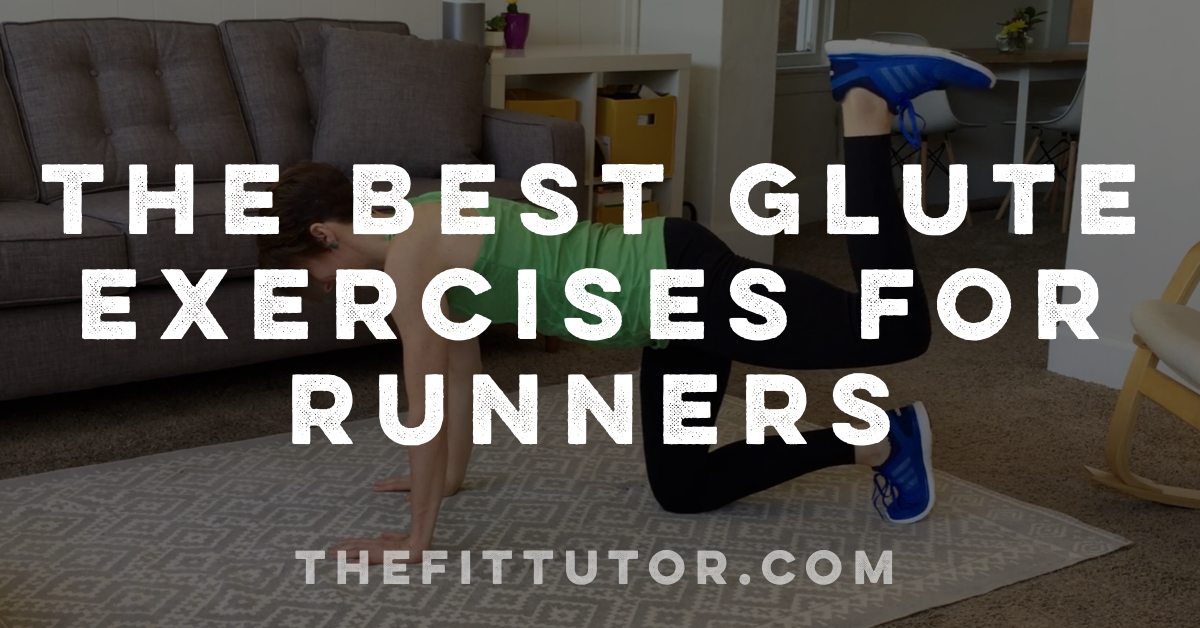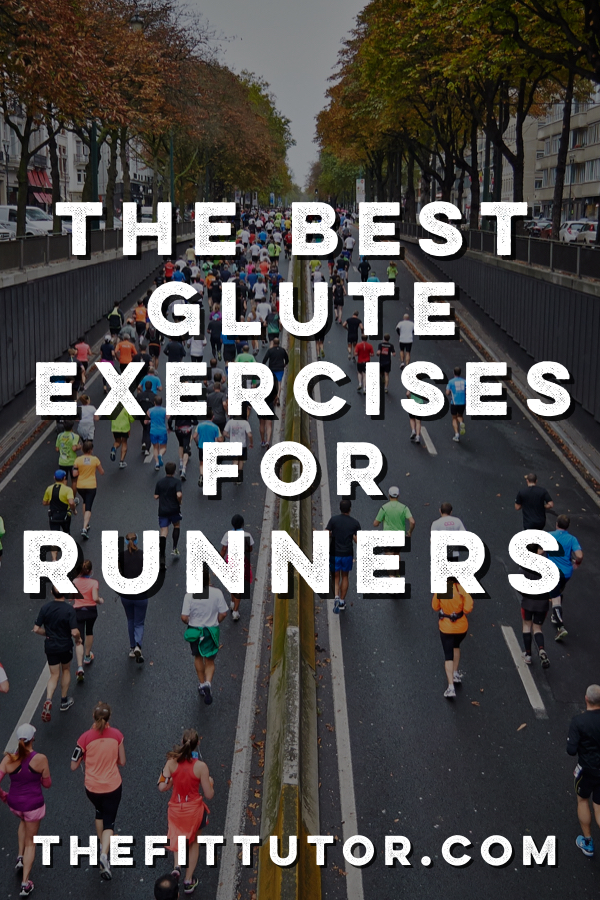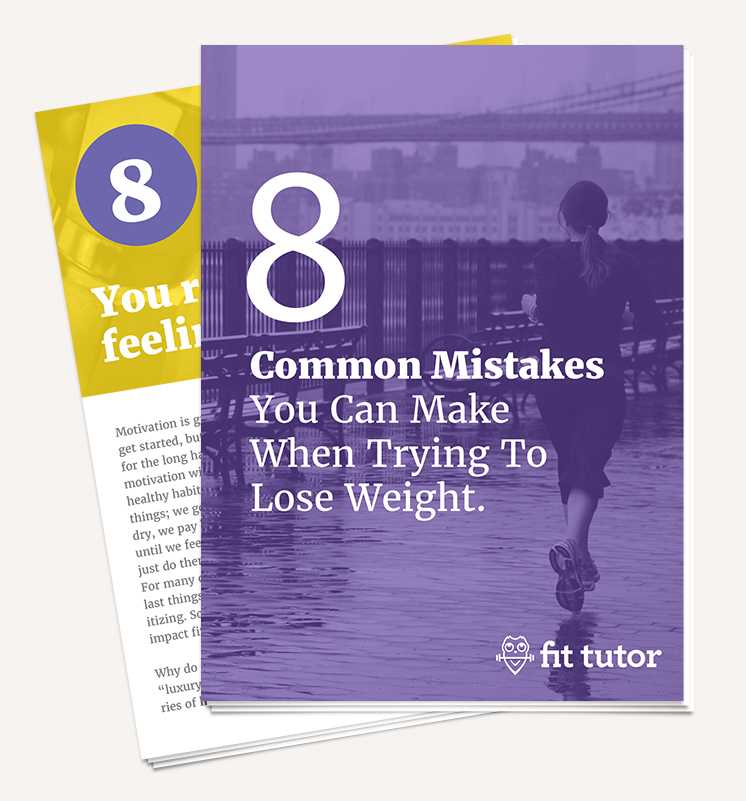Adding these glute exercises for runners to your routine will improve your speed and help keep you injury free! The repetitive movements in running create strong quads, calves, and hamstrings, but often leave you with weak glutes. Top top it off, glute exercises are commonly left out of strength workouts for runners. Do these 8 exercises described below and be one step ahead of everyone else!
Why Runners Should Work Their Glutes
Weak glute muscles have been associated with shin splints, achilis tendonitis, IT band syndrome, runner’s knee, and low back injuries. Adding these exercises into your training will improve your running and prevent these common injuries.
Butt Anatomy 101
The gluteal muscles are the biggest muscle group in your body! They include: the gluteus maximus, minimus, and medius. They do more than help you rock a pair of jeans (although they do that so well)! Your gluteus maximis helps you stand up from sitting, climb stairs, and stay upright!? That’s a big deal. It’s also our most powerful hip extensor, external rotator, and stabilizer, and helps bring our legs out to the side and back in (abduction and adduction).
The gluteus medius and minimus aren’t quite as big but are still crucial. They keep your hips in place while walking (I’m sure you’re seeing the connection to running by now….), they prevent your knees from caving in, and they help with hip extension, abduction, and rotation.
Long story short: runners need developed glutes.
Marathon runners, the occasional 5k-ers, and the shy woman who is afraid to come out as a runner because she doesn’t feel like an athlete. ALL Y’ALL need to train your butt.
If you sit all day, don’t even argue with me. Go lace up your sneaks and let’s get to strength training.
By the way, training your glutes comes with extra motivators, like increasing your metabolism, improving posture, promoting weight loss, etc.
I know that you’re on board now, friend, so let’s get to lifting! Here’s how:
8 Glute Exercises for Runners
I consider these to be top notch for at-home workouts with very minimal equipment (either none or a pair of dumbbells). They help activate the glutes for forward propulsion as well as strength. Adding these to your routine will make you a better runner and reduce your injuries. I’ll explain how to add them to your workout after I cover these awesome glute exercises for runners!
Hip Thrusts
Lie with your shoulder blades on a bench or couch, and spread your arms out for stability. Keep your feet flat on the floor, knees bent, with butt touching the ground. Drive through with your feet, squeezing your glutes, and extending hips up so your torso is straight (not hyperextended) and your knees are bent 90 degrees, not over your toes.
Pause at top. Slowly return until your butt just touches the ground and perform another rep. Keep your head in line with your spine throughout the movement. Add a dumbbell on your hips and secure with your hand(s) to make more challenging.
Fit Tutor Members can view a more detailed video with exercise progressions HERE
Sumo Deadlift
Position your feet about twice shoulder-width apart, your toes pointed out at an angle, and your dumbbells at your feet. Without rounding your lower back, bend your knees and grab them with both hands.
Press through your heels, thrust your hips forward, and stand up as quickly as possible, trying to keep your dumbbells close to your body. Pause, and then return to start by pushing your hips back and lowering the dumbbells back to the ground.
Things to keep in mind: Don’t round your lower back position at any point. Come to a full lockout when you come up by squeezing your glutes. Think about squeezing your butt and hamstrings and pushing your feet into the floor instead of it being like a squat.
Fit Tutor Members can view a more detailed video with exercise progressions HERE
Split Squats
Stand in front of a bench or couch. By stepping up and back, place one foot on the bench – toes curled or top of the foot flat on the bench- whatever is more comfortable.
Begin by lowering your body by flexing your knee and hip. Maintain good posture throughout the movement and try to keep your hips level- don’t let them sag or tilt to one side. Keep your front knee in line with the foot as you perform the exercise, and try to not let your knee go over your toes.
Lower down as far as you can, shooting for at least a 90 degree bend in your front knee, and press your heel into the ground and squeeze your glutes to extend your knee and hip to return to the starting position. Lean forward a little (while keeping good posture) on the way down if you feel any tension or discomfort in your back leg. Repeat reps on the other leg.
Fit Tutor Members can view a more detailed video with exercise progressions HERE
Single Leg Elevated Glute Bridge
Lying on the ground, place one heel on the back of a chair or bench. Keep your foot in line with your knee and your knee in line with your hip. Press your heel into chair and extend hips up until torso through your knee is in a straight line. Keep other leg up, almost straight. Focus on keeping your hips in line and not letting them tilt. Pause at the top, then slowly lower back down and start your next rep just before your butt touches the ground. Repeat on other side.
Fit Tutor Members can view a more detailed video with exercise progressions HERE
Donkey Kick
Get on all fours on the ground, keeping your hands underneath your shoulders, knees under hips. Lift one leg off the ground and bend your knee 90 degrees, keeping foot flexed. Squeeze your glutes to bring your leg up to hip level and slowly return lower back down. Repeat reps on opposite leg.
Clamshells
Lie on your side side with your head cradled in your palm. Bend your hips and knees in front of you 45 degrees.
Lift your knee of the top leg towards ceiling keeping your hips stacked. Make sure you don’t externally rotate your hip, which you would feel by rocking slightly backwards. Hold at the top for 2 seconds and slowly lower back to the start. Keep your feet together through the entire movement.
Fit Tutor Members can view a more detailed video with exercise progressions HERE
Walking Lunges
Start with your feet shoulder width apart and a dumbbell in each hand at your sides. Step forward with one leg, bending at both knees and dropping your hips straight down. Keep your posture tall and upright, and step far enough out so your knee doesn’t go over your toes. Each knee should be bent about 90 degrees.
Drive through the heel of the front foot and squeeze your glutes to extend both knees to come back up: either to the starting position or immediately start lunging with the opposite leg.
Fit Tutor Members can view a more detailed video with exercise progressions HERE
Fire Hydrant
Get on the floor on all fours with your hands and knees directly under shoulders and hips. Bring one knee as close as you can to your chest. From that position, raise your thigh out to the side by squeezing the side of your butt/hip. Do this without moving your hips.
Pause and extend your leg, then bend it again, and bring your knee back to the ground in the same pattern as you raised it. Repeat on the opposite side. (I added a kick at the end for good times’ sake)
Fit Tutor Members can view a more detailed video with exercise progressions HERE
How To Add These Glute Exercises for Runners Into Your Routine
First off, most runners aren’t going to want to do a “glutes only” day which is what doing only these exercises would be. You’ll want to add them into your full body strength routine. In case you’re slacking on strength training, you can read this post for more ideas, and keep in mind training your upper body, core, and your other leg muscles are really helpful, too. Just don’t make the mistake of neglecting your butt muscles!
The average runner will really benefit from adding 2-3 days of full body strength training in per week, working 12-15 reps of each exercise. That’s not the final word, though, so read this post if you’re training specifically for speed or endurance:
You can strength train before a lighter run, and be sure to really focus on your running form since your muscles will be tired. This is very challenging on your leg and core muscles especially and can improve their resilience. You can also alternate your running days with strength training days, keeping in mind strength training will enhance your running and is an important part of the training.
You also might want to check out this Running Month post contributed by a crazy-successful marathon runner about how to fuel your runs!
Keep these glute exercises for runners at the forefront of your training because they should help develop these neglected muscles and correct any imbalances you may have! Some are similar, so you can split them up into different full-body workouts, including exercises from this workout. You could split up split squats and walking lunges, hip thrusts and single leg elevated glute bridges, clamshells and fire hydrants, for example, into separate workouts.
…Or Think Less and Follow A Training Plan
It’s Running Month at The Fit Tutor… most articles this month are geared towards helping all levels of runners. Each Weekly Workout created in May (5 total!) is designed to help strengthen your full body and work out muscle imbalances commonly found in runners.
Spoilers: the aforementioned glute exercises for runners are included and combined with other exercises for awesome full body workouts designed by a nationally certified trainer!
It’s members-only content, but it’s yours with our super affordable memberships! Use these workouts to see how to put together a bangarang strength program to enhance your running game.
A membership gets you our exercise library with mods/instructions/demos, a workout creator to make your own bad@$$ running workouts, a nutrition course that includes meal plans, and many results-driven workout programs! Check out our membership options here!
Pin or share this so you have it for later!




Comments are closed.